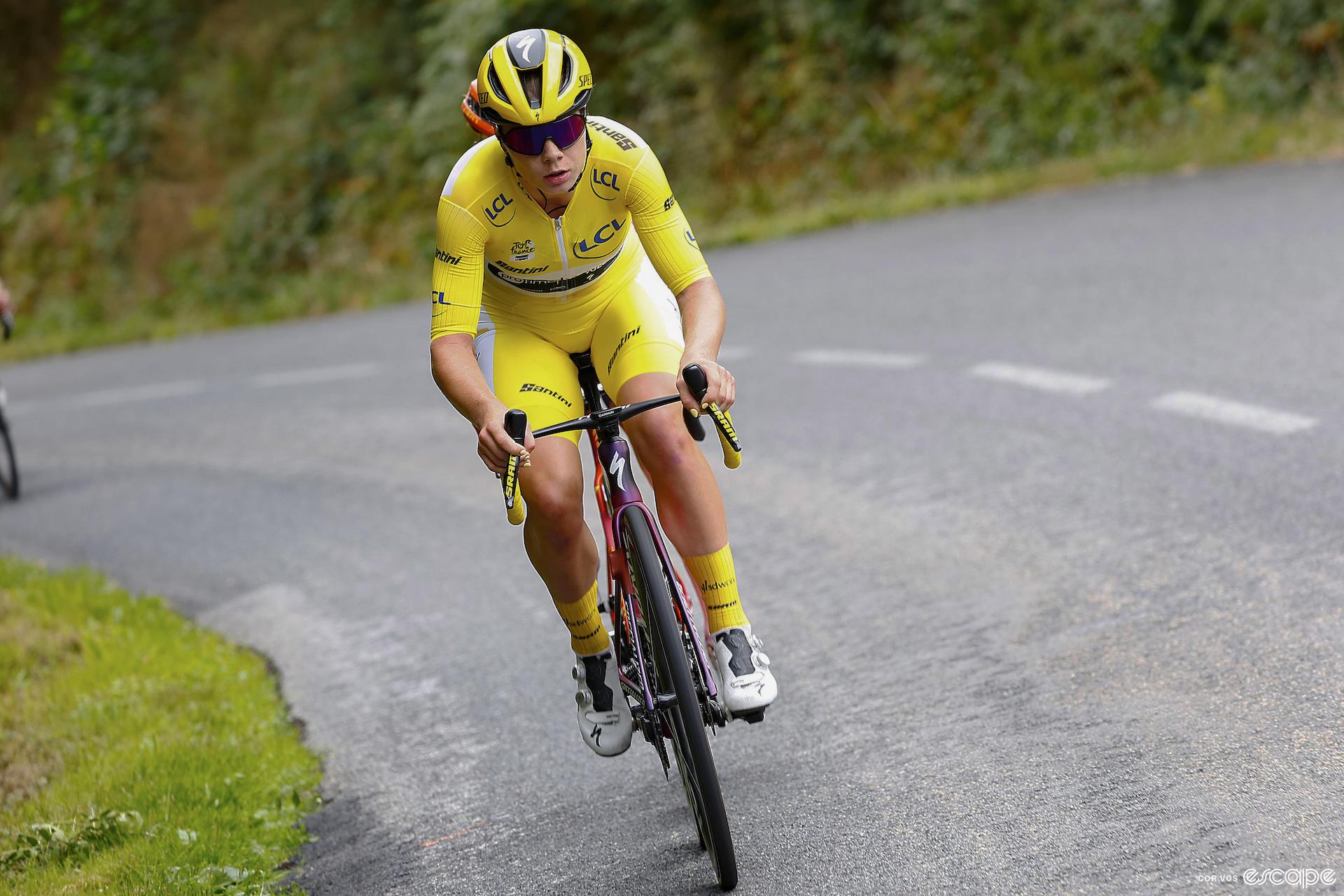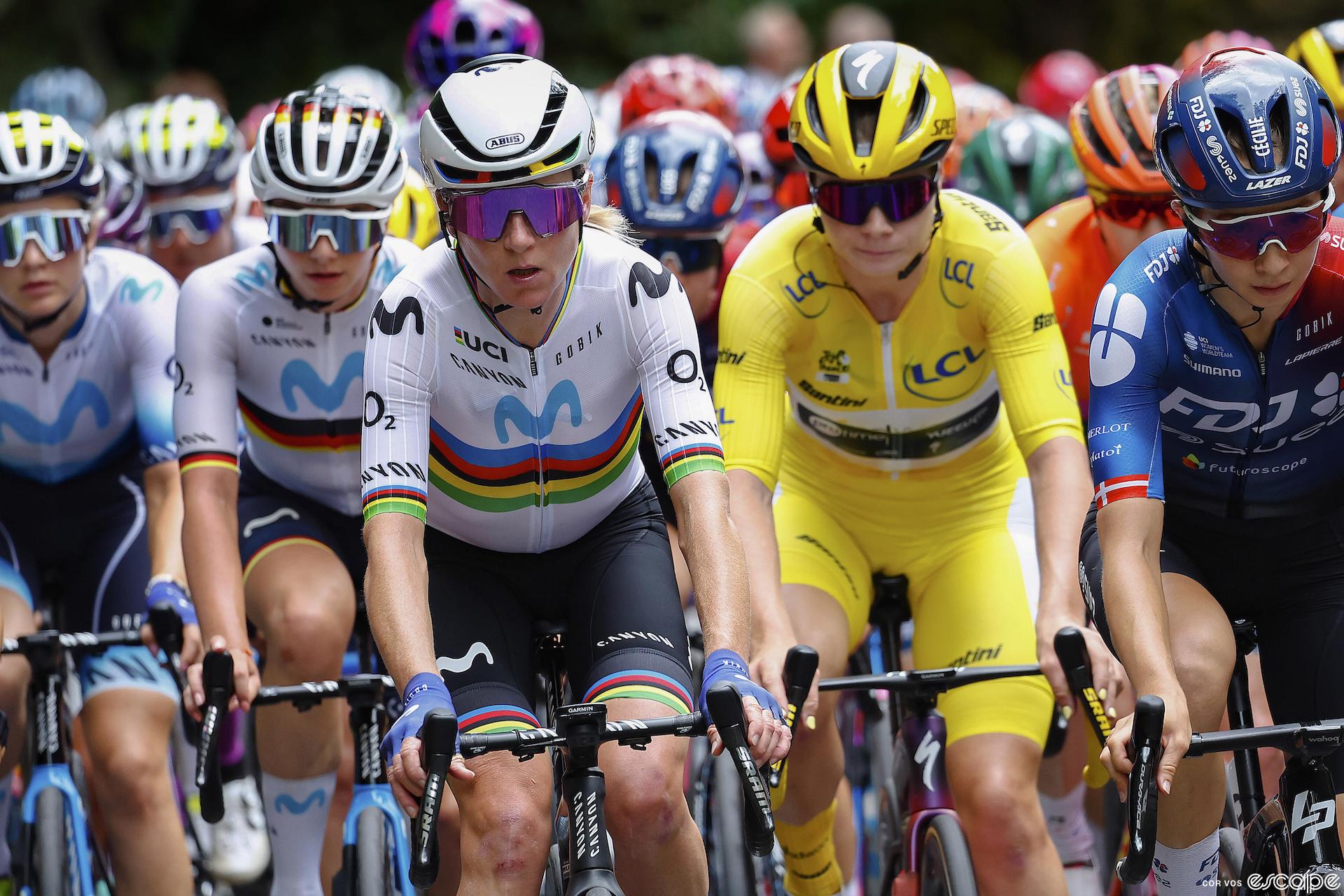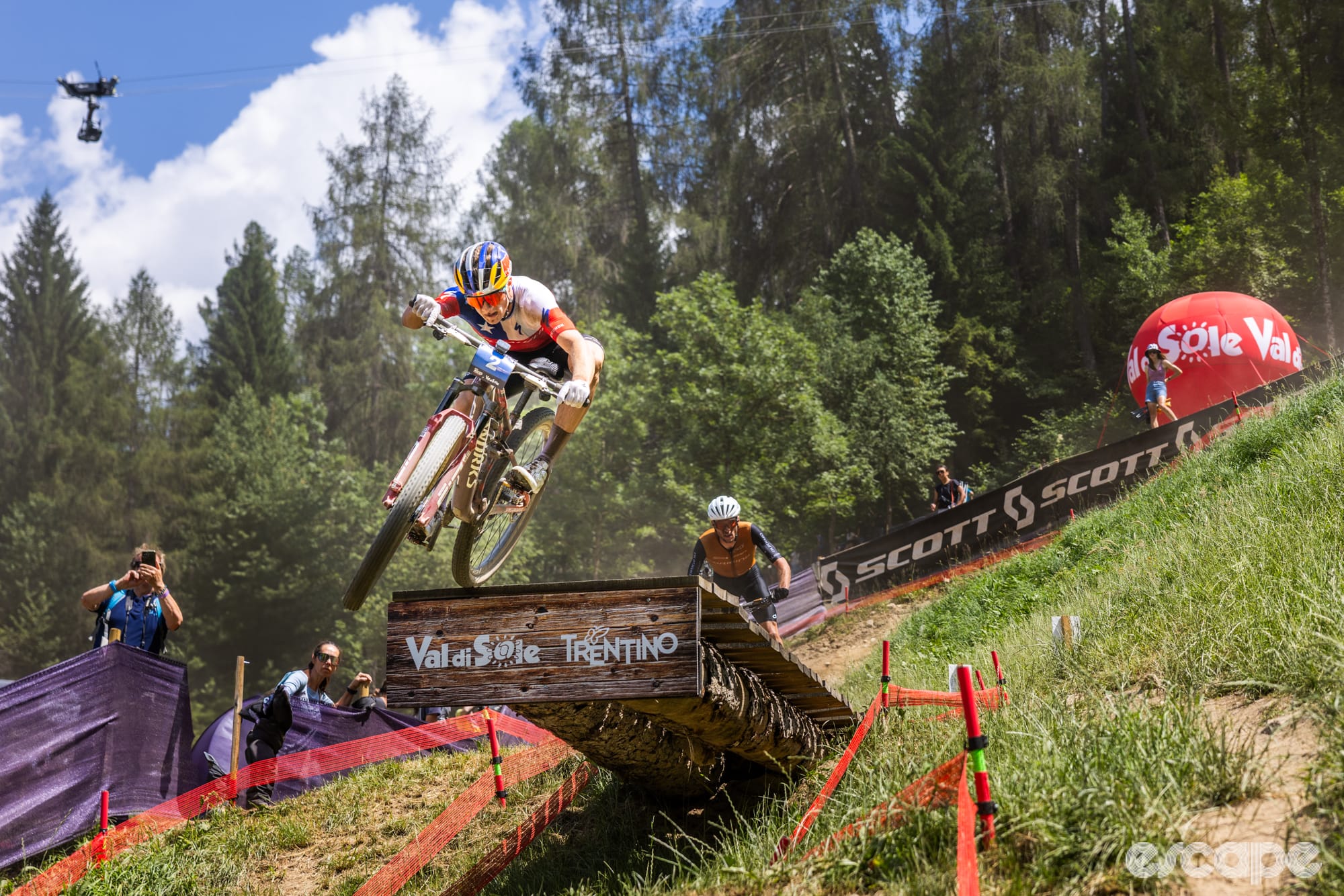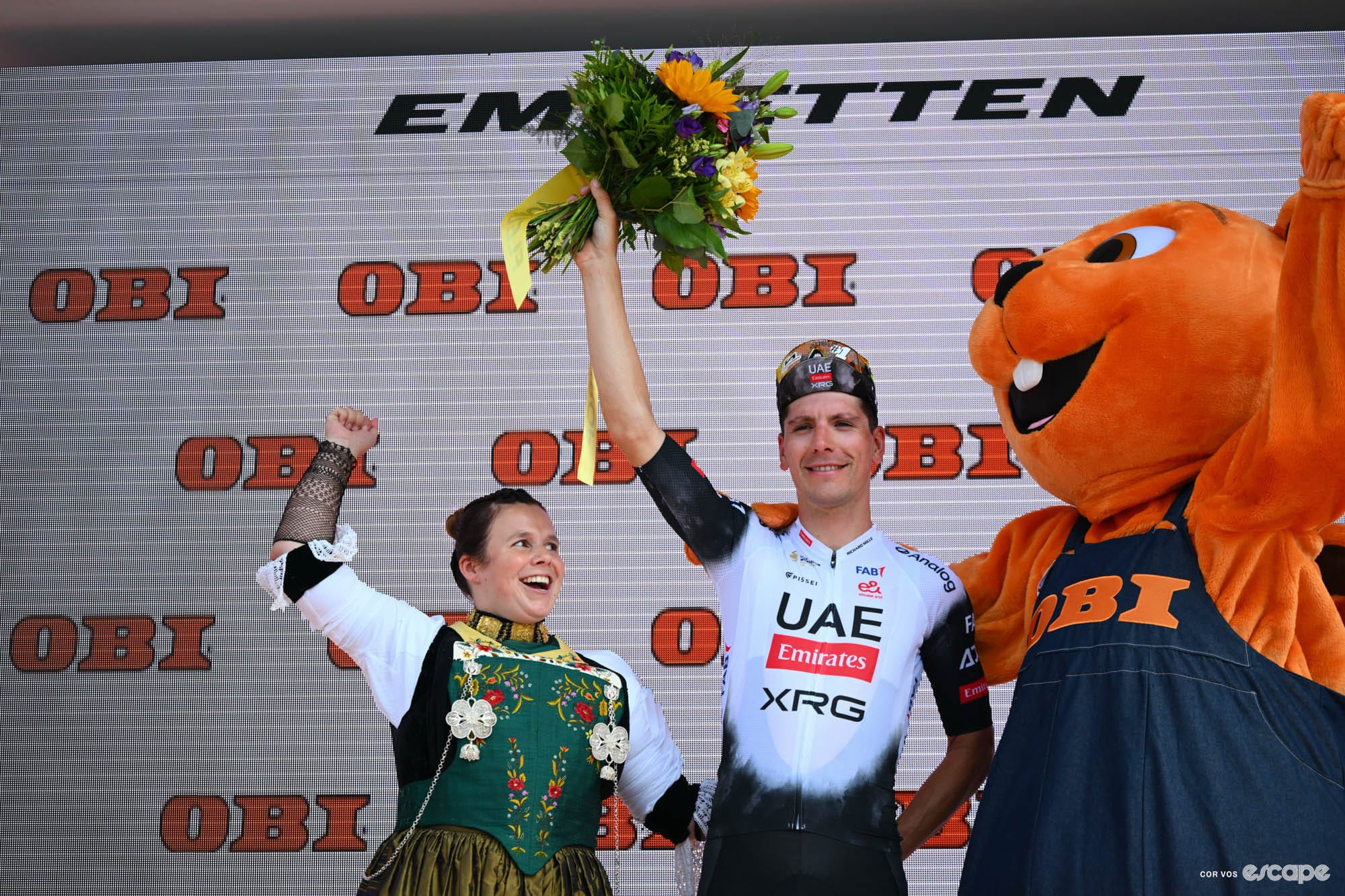The fourth stage of the Tour de France Femmes went to the breakaway, but as expected the general classification favourites still tested each other on the four climbs before the finish.
The last 20 km was full on, with attacks from almost all the top favourites to take the final yellow jersey on Sunday. Unsurprisingly, most of the aggression came from SD Worx, the team of the current yellow jersey wearer Lotte Kopecky. What was surprising: it was Kopecky who was making moves as the final climbs pitched and rolled, slowly shedding riders from the back of the main peloton until it was only the favourites left.
"We know [SD Worx] for having strange tactics, but they're efficient tactics so chapeau to them for how they played it all; in the end, it was just really really hard," Lidl-Trek's Elisa Longo Borghini said at the finish. "It was one attack after the other."
The day was a hard one, even if you don't factor in the length. With a series of climbs and a final kicker to the line containing grades of 15%, the day was always going to challenge the general classification, and even if gaps weren't formed between the favourites, a solid picture of what's to come still came to light.
From early on the stage looked like it was going to the break. The group of 14 even had a gap of over 10 minutes at one point, but all it took was SD Worx putting three on the front to make the attackers question their attempt.
When the gap was still over five minutes and with 35 km to go Kopecky made her first move, with Kasia Niewaidoma glued to her wheel. Behind her, the peloton was still large, and Lidl-Trek was quick to close the move down. Even after Lidl-Trek closed the move with Lizzie Deignan, Kopecky kept the pace and the efforts of the yellow jersey brought the gap down rapidly.
The general classification moves started to come thick and fast once it was clear SD Worx was ready to play. The gap dropped, but in the break, Yara Kastelijn threatened Kopecky's jersey.
"At one point it was pretty confusing because I didn't really know what the time gap was. On this final climb, we managed to bridge a few riders but I didn't know how many were in front," Kopecky said after the race.
Kopecky’s attacks were not, as people may have suspected, an attempt to keep the yellow jersey when Kastelijn moved into the virtual lead. The team and Kopecky have been adamant that the end goal was Vollering in yellow, and Kopecky reiterated that after the stage.

"It was mainly to help Demi try to go on the attack and hoping she could get rid of the other riders and I could help her towards the finish,” Kopecky said of her aggressive late race behaviour.
Once Kopecky was done attacking it was Vollering’s turn, and as soon as the WorldTour points leader hit the front it was clear what the plan had been all along. Very soon after Kopecky’s final move was reeled in the real GC riders came to the fore.
As the stage progressed different riders looked strong at different times, but always it was Annemiek van Vleuten and Vollering with the race on their side. After any given attack another GC contender either looked great or was dangling off the back.
Most of the action took place on the Category 2 Côte de Moyrazès and the Category 3 Côte de Lavernhe. Once that final climb was finished and the dust settled seven riders emerged as GC contenders. On the climbs, attacks flew from Vollering, Van Vleuten, and Niewiadoma and as the race reached its end Juliette Labous, who lost nearly 90 seconds on the first stage, made a solo attempt to find some time.
"Definitely it was hard because everyone was hoping to drop some GC contenders and there were a lot of opportunities,” Niewiadoma said after the stage. "To start with we were going up and down all the time so it was everything or nothing. The pace was very unsteady and that makes it very difficult for your legs because after the first part which was super boring and slow your legs kind of feel sleepy, so that was definitely a painful experience.”
"It was cool to feel part of the front group and not feel that you really suffered to be there so it was good for my confidence for the next days.” Niewiadoma, who has looked strong all week, sits in fourth overall ahead of the fifth stage. The Polish rider on Canyon-SRAM finished third overall in the inaugural edition of the Tour de France Femmes and has been open about her intention to improve upon that performance in this year’s edition.
"I haven't lost any precious time towards the main GC contenders so that's the positive for me,” Niewiadoma explained. "Overall I would say that so far I am happy I am part of the main battles with the GC contenders and I can actually test my legs and see who is the strongest or who is on my level and take some notes for the upcoming days.”
Another strong performance on the day was Ashleigh Moolman Pasio, who finished seventh on the stage and held onto her third overall GC spot.
"We did nothing to chase, we wanted to put all the pressure on SD Worx of course because they’re defending yellow,” Moolman Pasio told the Wheel Talk Podcast. "They didn’t seem to do the best of jobs bringing it back and it was interesting to see they were chasing each other down at the end of the day, once again interesting tactics from SD Worx.”
"Everybody was in my wheel,” Demi said of the stage. "And I think also they let Lotte go because I think probably they knew already, okay, this is probably their plan. So that was a bit shit.”
As she’s not, in theory, a threat for the final general classification come the Col du Tourmalet, it made sense for the rest of the favourites to mostly ignore Kopecky’s move. After Tuesday’s stage, when SD Worx tricked the peloton into doing their work for them, no one was going to fall for their sneaky moves again.
"We tried our best and in the end, I think I was second,” Vollering said. "I didn't know because I had no clue what was happening, so I celebrated anyways.”
"But it was a crazy day. Also, because we don't have so much, so long races, you really feel it in the bunch. Everybody's really tired and nobody has that really explosive attack anymore to go away."
One rider who snuck under the radar a bit was Longo Borghini. She finished fifth on the day, but she was rarely seen doing any work. She wasn’t looking her strongest on the first day but still finished with the front group. It would appear her legs are coming around based on her sneaky ride on Wednesday.
"We wanted to go from km 145 and attack the second [to] last climb but we skipped it because we had Lucinda [Brand] in the front and we thought it was a good opportunity to grab a stage,” Longo Borghini said. "SD Worx started attacking with the yellow jersey and then on the second to last climb Vollering and Annemiek went away like 200 meters to the top and then we caught them back.”
"From then on it was going full gas into the last climb where we caught almost the entire breakaway except Yara Kastelijn who had a great line. I sprinted to the line, still a good result for me, not a stage win but it's a good thing for the GC.”
It’s still up in the air how the legs of Van Vleuten are feeling. The World Champion attacked a few times but it was the final climb that showed her cards.
"I suppose that's how it goes, cat and mouse, and that obviously played a little bit into my favour, so I'm grateful for that,” Van Vleuten said of the day's tactics. "This final climb was a bit strange. I couldn't decide whether to stay in the big chainring or go down to the small chainring, and then coming into the final, it flattened off again."
“[I am] happy with my performance and I think many days to come, more and more legs are getting tired, and I think this is where I can make the difference."
While Moolman Pasio, Niewiadoma, Longo Borghini, and Van Vleuten are still tied on time in the general classification, with Vollering leading the favourites by eight seconds thanks to some finish-line bonuses, a lot can be taken away from the fourth stage.
Mainly, neither Van Vleuten nor Vollering could ride away – not just from each other, but the rest of the contenders.
"Everybody can follow so that makes it really even harder,” Vollering said of her attempts. "Because normally I think multiple riders can make a difference on the climbs, but now everybody was a bit the same level. So, yeah, that made the difference.”
Stages 5 and 6 aren’t as challenging as the fourth stage, but the way some riders are racing no day is off limits, especially for Niewiadoma, who never misses an opportunity to at least try. Longo Borghini and Moolman Pasio are keeping their cards close to their chest, and both are frightening prospects for the days to come. Meanwhile, Labous is willing to lose, and that’s something you never want your competitors to feel.
Van Vleuten and Vollering still look like they’re the strongest after the fourth stage, but a handful of other riders clearly came into the race with a plan and things are about to get a lot more interesting.
Did we do a good job with this story?




